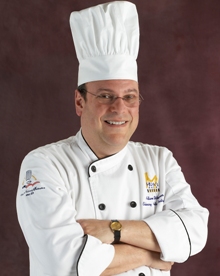At-a-Glance Refresher
31 May 2009By Adam Weiner, JobTrain and the Sequoia Adult School
To help the student who’s prepping for an interview, share this compendium of need-to-knows.
One of our key responsibilities as instructors is to make sure that our students can do well in interviews. If they cannot give a good interview, they can’t get a job. I repeatedly work on teaching soft skills to my students on how to interview. I will write about that in the next issue of The Gold Medal Classroom.
Below is a culinary cheat sheet that I give to my students to study before every interview. Now, it probably isn’t useful to just copy it as is, but it might be useful to you to modify it for your students.
-
Remember the Five “P”s:
Planning, Preparation, Presentation, Passion and Pride
-
Always clean as you go.
-
Knife Cuts
- Always use a steel when you take a knife off the rack.
- Damp towel under the cutting board
- Rock the knife, don’t slam it on the board. Move food to knife. Knife stays in one place.
- Keep the fingers on the other hand curved—eyes only on cutting board
-
Cut sizes:
Large dice: ¾ x ¾ x ¾ inch cube
Medium dice ½ x ½ x ½ inch cube
Small dice ¼ x ¼ x ¼ x ¼ inch cube
Brunoise 1/8 x 1/8 x 1/8 inch cube
Fine brunoise 1/16 x 1/16 x 1/16 inch cube
Batonnet 2 x ¼ x ¼ inch long
Julienne 2 x 1/8 x 1/8 inch long
Fine julienne 2 x 1/16 x 1/16 inch long
-
Abbreviations and Measurements
C = Cup 3 t = 1T
T = Tablespoon 1 G = 3.75 liters
t = Teaspoon 1 liter = 34 fl oz
oz = Ounce 1 pt = 16 fl oz = 480 ml
FL = Fluid 4 qts. = 1 gallon
LB = Pound 8 pts = 4 quarts
Gal = Gallon 1 qt = 32 fl oz = 960 ml
F = Degrees Fahrenheit 4 C = 1 qt
C = Degrees Celsius 1 C = 8 fl oz = 240 ml
qt = quart 2 C = 1 pt
pt = pint 1 C = 16 T
16 oz =1 pd
-
Water boils at 212 degrees F or 100 degrees C
Water freezes at 32 degrees For 0 degrees C
-
Mother sauces.
- Hollandaise is butter and egg yolks.
- Tomato Sauce is tomatoes plus stock and often a roux.
- Espagnole (Brown Sauce) is brown stock thickened with a brown roux.
- Béchamel is milk combined with a white roux.
-
Velouté is white stock combined with a blond roux or even a white roux. The stock can be veal, chicken or fish.
-
Kitchen Safety
- If you haven’t been trained on a piece of equipment, don’t use it.
- Say “Behind You” when walking behind someone.
- Say “HOT” when carrying a hot pot or pan across the kitchen.
- Say “Knife” when carrying a knife across the kitchen.
- Wear non-skid shoes, chef coat, chef pants.
- No cell phones on kitchen floor.
-
Never let any liquids near the fryer.
-
Food Safety
- Wash hands for 20 seconds (“Row, Row, Row Your Boat” or “Happy Birthday” sung twice) when coming into the kitchen after using the restroom, or any time you have touched something that might be contaminated or potentially hazardous.
- Don’t let foods stay in the danger zone between 42°F and 140°F. Hold food above 141°F or below 41°F
- Remember, bacteria need FAT TOM: Food, Acid (lack of acid actually), Time, Temperature, Oxygen, Moisture.
- Avoid cross-contamination.
- Remember HACCP.
- Wear hair restraints, clean aprons, clean uniforms.
- Label all stored food.
- The easiest way to prevent rodents and insects is to keep them outside
-
There are only four legal ways to defrost things: in the reefer, under COLD RUNNING water, in the microwave and then cook immediately, or just cook straight from the freezer.
-
Cooking Temperatures.
Ground Beef, Pork, Veal, Lamb: 160°F
Ground chicken, turkey: 165°F
Beef, veal, lamb: 145°F rare, 160°F medium,170°F well done.
Poultry: 165°F
Stuffing inside poultry: 165°F
Pork: 160°F medium, 170°F well.
Eggs: Cook until white is firm and yolk nearly firm.
Egg dishes: 160°F
Fin fish: 145°F or opaque and flakes easily.
Clams, Oysters, Mussels: When shells open. Discard any that don’t open.
Shell fish: Just after it turns opaque. Don’t over-cook.
Casseroles: 165°F
Leftovers/reheating: 165°F , and only reheat once.
Note: Many chefs will want things done to a different temperature. When in doubt, check with the chef.
 Chef Adam Weiner teaches a 20-week Introduction to Professional Cooking Program for JobTrain and the Sequoia Adult School on the San Francisco Peninsula. Graduates have gone on to work at Stanford University and Medical Center, Bon Appétit Management Company, Royal Caribbean Cruises, Hyatt and Four Seasons Hotels.
Chef Adam Weiner teaches a 20-week Introduction to Professional Cooking Program for JobTrain and the Sequoia Adult School on the San Francisco Peninsula. Graduates have gone on to work at Stanford University and Medical Center, Bon Appétit Management Company, Royal Caribbean Cruises, Hyatt and Four Seasons Hotels.
Weiner has a California Vocational Teaching Credential and has written more than 40 articles for four different publications. He was nominated by the local ACF chapter as Chef of the Year 2008 and is the Chef Association of the Pacific Coast’s education chairperson. He is also an instructor for the U.S. Navy’s Adopt-A-Ship program.
